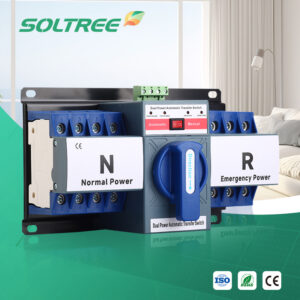electricity outages can happen at any time, and not all transfer switches work the same way. It’s important to choose the appropriate one to keep the electricity on.
There are several kinds of Automatic Transfer Switches (ATS), such as open transition, closed transition, delayed transition, and gentle loading. Each one is made for a certain backup power need.
Choosing the correct ATS makes sure that it works reliably, safeguards equipment, and lets electricity flow smoothly during power outages. We’ll look at the different sorts of ATS, what they do, and where they’re most often used below.

Open Transition ATS
Sudden power shortages can hurt delicate equipment, but open transition ATS makes it easy to fix.
An open transition ATS moves load by cutting off power from the utility and then connecting to the generator. This makes a short interruption in electricity.
How It Works
This is the most popular and least expensive type of ATS. It uses a “break-before-make” mechanism to make sure that the generator and the utility are never connected at the same time.
Important Features
- Short power outage during transfer
- Design that is simple and dependable
- Best for loads that aren’t important
- Used a lot in homes and small businesses
Closed Transition ATS
For important tasks, even a short outage can be undesirable.
A transition that is closed ATS moves load without stopping, first putting the generator and utility in parallel for a short time before switching completely.
How It Works
This “make-before-break” strategy makes sure that the handoff goes well. This is especially helpful for places that need power all the time, like hospitals or data centers.
Important Features
- No loss of electricity during transfer
- Needs to be in line with other sources
- More expensive and complicated
- Best for applications that are really important
Delayed Transition ATS
Some equipment, like big motors or HVAC systems, needs time to get used to a new power source before it can be used again.
A transformation that takes longer ATS temporarily stops in a neutral state so that any leftover energy in the connected equipment can leave before it changes sources.
What It Does
This keeps electrical spikes from happening when moving big weights. It makes transitions safer for sensitive mechanical or electrical systems by adding a small delay.
Important Features
- A neutral latency before reconnecting
- Safeguards substantial inductive loads
- A little power outage
- Common in factories with big machines
Soft Loading ATS
Some places with very sensitive processes may need more than just rapid switching.
A soft loading ATS slowly moves the load between power sources, which helps both the utility and generator by balancing the load and lowering stress on both.
How It Works
This type uses advanced control to slowly increase or decrease the flow of electricity, which helps keep voltage and frequency stable. It’s commonly an element of advanced systems for managing power.
Main Features
- A smooth transfer with little disruption
- Lowers stress on machines and electricity
- High price, complicated design
- Found in big factories or utility settings
Comparison of ATS Types
| ATS Type | Transfer Style | Power Interruption | Best Use Case |
|---|---|---|---|
| Open Transition | Break-before-make | Yes (brief) | Homes, small businesses |
| Closed Transition | Make-before-break | None | Hospitals, data centers |
| Delayed Transition | Break → Pause → Make | Yes (slight delay) | Facilities with large motors |
| Soft Loading | Gradual transfer | None | Industrial/utility-scale systems |
Conclusion
Automatic Transfer Switches are not the same for everyone. Open transition ATS is easy to use and doesn’t cost much, while closed transition ATS delivers uninterrupted power for important places. Delayed transition keeps heavy equipment safe, and gentle loading makes sure that transfers go smoothly and in a regulated way for very sensitive or huge systems. You may choose the ATS that best meets the needs of your facility by knowing the strengths of each type. This will make sure that the system is safe and reliable when the utility power goes out.



